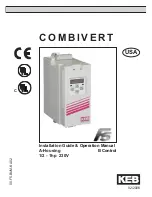
15
In order to prevent a malfunction caused by interference voltage on the
control inputs, the following steps should be observed:
• Establish a common ground point for all ground connec-
tions.
• Use shielded cable with twisted pair wires.
• Terminate shield wires to earth ground, only at inverter.
• Separate control and power wires 8" or more apart.
• Control and power wires to cross at a right angle.
PIN
Function
Name
Description
1
+ Analog input 1
AN1
Voltage input for speed
resolution: 11 Bit, 0...±10 VDC
^ 0...±CP.11, scan time: 2 ms
5
Analog output 1
ANOUT1 Analog output of the actual
voltage range: 0...±10 VDC
output frequency
^ 0...±100 Hz, Rout = 100 k
Ω
,
resolution: 12bit
7
+10V Output
CRF
Analog supply voltage for speed ref. +10 VDC +5%, max. 4 mA
8
Analog Common
COM
Common for analog In- and Outputs
10
Fixed frequency 1
I 1
I1 + I2 = Fixed frequency 3;
11
Fixed frequency 2
I 2
no input = analog voltage (speed) ref.
14
Forward
F
Preset rotation;
Ri = 2.1 k Ohm
15
Reverse
R
Forward has priority
scan time: 2 ms
16
Control release, Reset ST
Inverter enable, disable;
Error Reset at opening
20
24V-Output
Vout
Approx. 24V Output (max.100 mA)
22
Digital Common
0V
Common for digital In-/Outputs
24
Relay 1, NO contact
RLA
Relay output;
25
Relay 1, NC contact
RLB
fault relay(default);
26
Relay 1, switching cont. RLC
Function can be changed with CP.31; max. 30 V DC, 1 A
27
Relay 2, NO contact
FLA
Relay output;
28
Relay , NC contact
FLB
frequency dependent switch (default);
29
Relay 2, switching cont. FLC
Function can be changed with CP.32; max. 30 V DC, 1 A
Installation and Connection
3.4.2 Connection
of the control
signals
1 5 7 8 10 11 14 15 16 20 22
24 25 26 27 28 29
X2A
3.4.1 Terminal Strip Connections
3.4 Control Circuit: F5-BASIC
EMC
















































